A pomander is a decoration accessory that was common in European countries in the Middle Ages and early modern times. Meaning "fragrant apple" (pomme d'ambre) in French, the accessory was first brought by European sailors from India (approximately in the 13th century) and was used as a container for storing aromatic oils (amber, musk), fragrant herbs and incense.
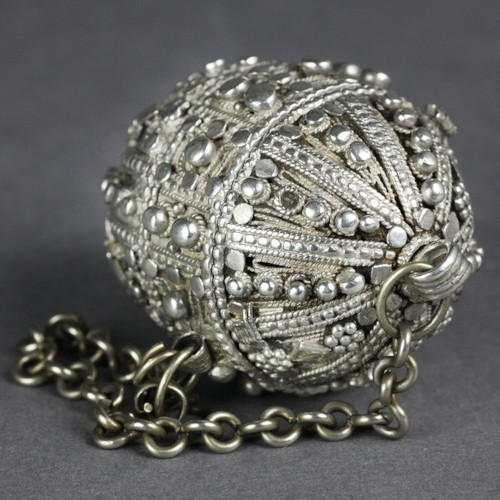
Nowadays it is an elegant decorative festive decoration that is easy to make yourself from citrus fruits, various spices or essential oils.
Story
A pomander is an elegant container made of precious metals for aromatic oils, which served in the Middle Ages not only as an elegant decoration, but also as a means of combating unpleasant odors.
Pomanders were extremely popular at the French court of Louis XIII, used to scent boudoirs, living rooms and bedrooms. The first Europeans to use the "metal ball", brought there from the East in 1350, were the Italians, at the court of the Medici dynasty, which had previously become famous for its trade.
Resembling a small ball made of precious materials, the pomander was first used as a reliquary and later turned into a costume decoration.
In addition to its decorative value, the pomander, nicknamed the “metal doctor,” was also used to mask unpleasant body odor and was considered a remedy for infectious diseases that were transmitted through the air, according to the “Miasma Theory” that prevailed from the time of Avicenna until the 19th century.

According to the Venetian medieval doctors (described in the "Theory of Miasmas") the "metallic doctor":
- helped fight "plagues" (infectious diseases);
- relieved renal colic;
- restored “male” strength and treated infertility.
The pomander gained its greatest popularity as a “metal healer” during the plague epidemic, being considered almost the most effective means for preventing the disease.
Filled with expensive oriental incense, the pomander became a luxury item, available only to members of the highest aristocracy. Precious metals (gold and silver) were used to make it, decorated with crystal, filigree patterns or precious stones.
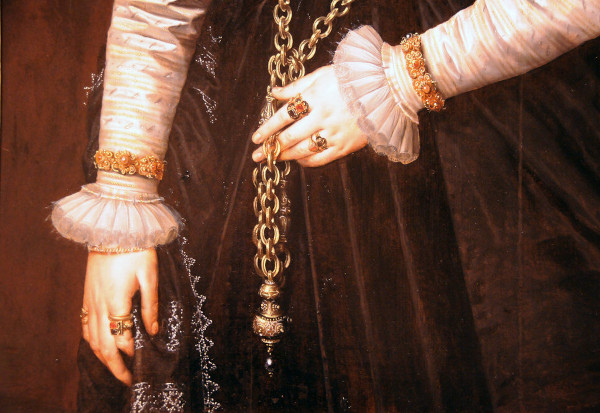
To attach the pomander, a thin gold chain was worn around the neck or belt, or a rosary was used. Small pomanders could also be made in the form of a ring. Inside, the pomander was shaped like a ball or divided into folding and opening sections, each of which contained aromatic substances.
The pomander resembled an apple, a heart or a skull (the most popular form of the product in the 15th-17th centuries, made in the "memento mori" style), a ship, a small book or a nut. At the end of the 18th century, the pomander was gradually replaced by perfume and cologne, and reappeared only at the beginning of the 20th century as an aromatic fragrance for linen.
Types of Pomander
Pomander is a dry flavoring made from citrus fruits with the addition of aromatic spices. The birthplace of the "citrus" pomander is considered to be England, where it, along with other toys, was an invariable decoration of the Christmas tree.
In the classical sense, a pomander is an aromatic ball, resembling an apple or orange in shape, with a common space or divided into folding and opening parts. Each of these parts was filled with fragrant substances and had holes through which the smell spread.
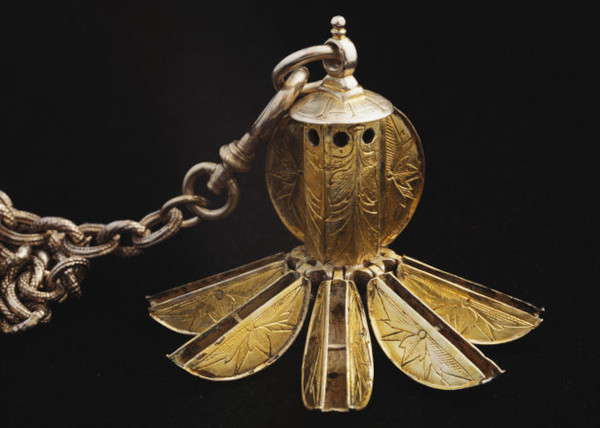
In the modern world, the role of a pomander can be performed by either a spherical object or a sachet with decorative herbs filled with essential oils.
Depending on their type and shape, pomanders are divided into:
| Pomandare species | His characteristics |
| Metallic | A classic, spherical design made of precious metals that served as a fashion accessory and was used to mask unpleasant room or body odors. This pomander gained its greatest popularity in France, Italy, and Spain in the 14th–18th centuries. |
| Citrus | Christmas pomanders first appeared in England in the 19th century. This accessory was made from citrus fruits (oranges, lemons), filled with cinnamon, cloves and cardamom and used as a decoration for the New Year tree. |
| Floral | A spherical bouquet consisting only of inflorescences tightly adjacent to each other. Suspended on a ribbon, such a pomander is used in European floristry to decorate the bride's dress and her bridesmaids' dresses at weddings and graduation balls. |
What do you need for the job?
Pomander is a traditional sachet decoration that came to Europe from the East and is used to decorate the New Year tree, decorate and aromatize the room.
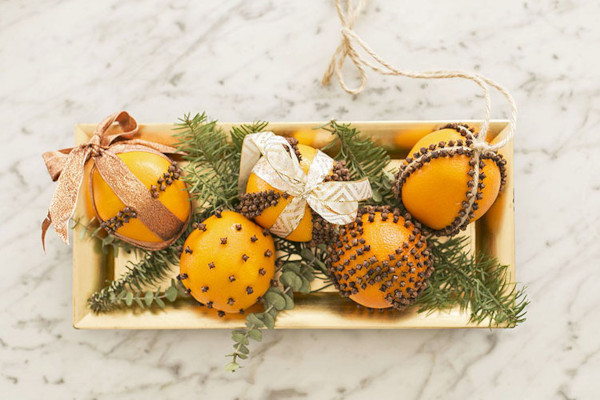
To make the product yourself, you need to have:
- several small, firm, thin-skinned oranges, lemons, limes, spherical apples;
- spices that go well with citrus fruits or aromatic oils;
- tape for fastening (paper strips or elastic band);
- satin ribbons for decoration of any color;
- toothpicks for fixing the structure;
- awl;
- paper bag or napkin.

To prepare the aromatic mixture you will need:
- ground cardamom;
- nutmeg;
- coriander;
- ginger;
- ground cloves;
- violet root;
- ground allspice (Jamaican) pepper;
- vanilla.
DIY Techniques
A pomander is a traditional Christmas (New Year) decoration that first appeared in England and was used to decorate the New Year tree.
From orange or tangerine
You can make a scented decoration from any fruit with a thin skin, but for a classic Christmas pomander, oranges, lemons or tangerines are used.
- To prepare a pomander, an orange (or any other fruit with thin skin) should be dipped in warm (not hot) water for 20 minutes. After the specified period of time, the fruit should be removed from the water, dried and tied crosswise with any (not satin) ribbon or strips of paper (rubber bands), securing them with toothpicks stuck into the fruit.
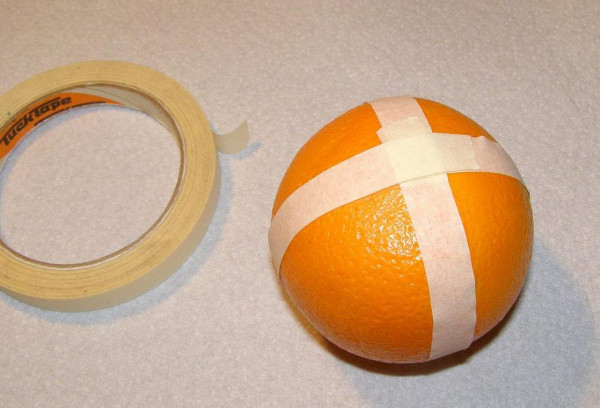
- In the free areas of the peel, use an awl (or toothpicks) to make small holes into which you need to place the clove buds.
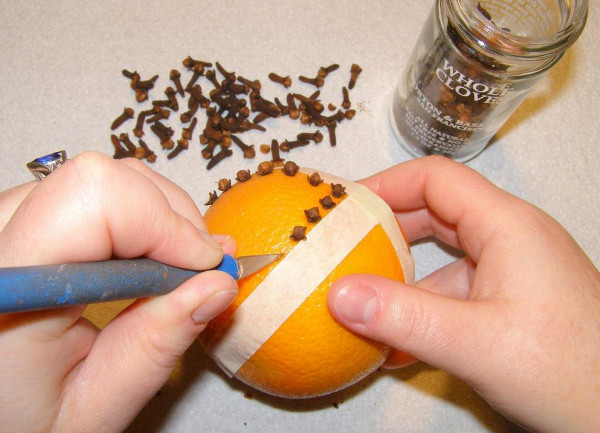
- The fruit prepared in this way should be placed in a paper bag (or on a napkin) and sprinkled with a mixture of spices. After this, the paper bag should be tightly closed and placed in a warm place (on a radiator) for 2-4 weeks or in an oven heated to 100°C and dried for about 2-3 hours.
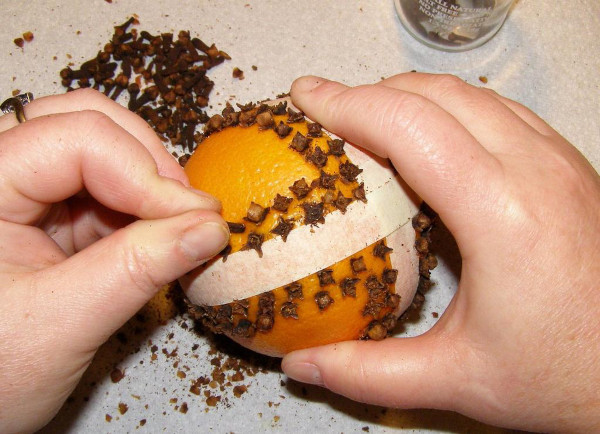
- After the specified period of time, the dried fruit should be removed from the paper bag, shaken off excess spices and tied with satin ribbons. The finished decoration can be hung on the Christmas tree or used for decorating and aromatizing the room.
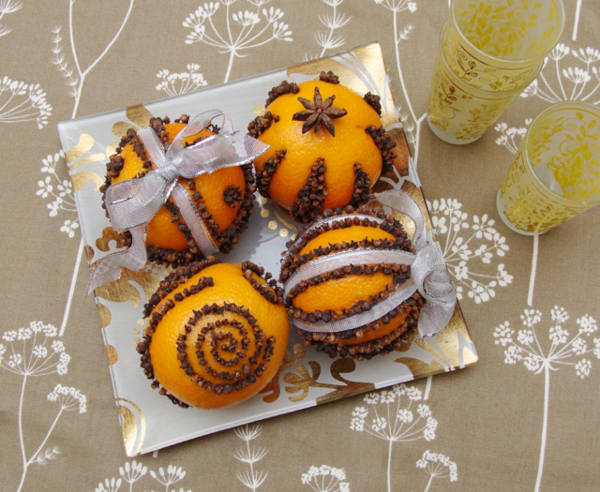
To prepare the spice mixture, you need to mix:
- ground cinnamon (100 g);
- ground cloves (100 g);
- nutmeg (50 g);
- ground allspice (50 g);
- crushed violet root (50 g).
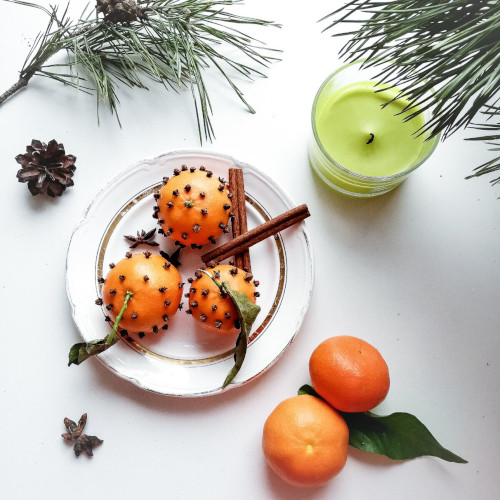
According to the decorators, the quantity and choice of spices for making a pomander can be any and should match the fruit chosen as the base.
With braid
A pomander with a ribbon is a bright and original decoration for the New Year, made from an orange, lemon or apple.
Materials and tools:
- thin-skinned fruits;
- an awl or toothpicks;
- carnation;
- braid;
- scissors;
- pin.

How to do:
- An orange, lemon or apple should be wrapped with tape so that 4 turns are obtained and fixed in the central part with a pin. To create a loop in the center, it is necessary to leave an additional amount of tape.
- Using an awl or toothpicks, make one row of cloves on each side of each turn of the ribbon. There should be 8 rows in total. The spices should be stuck into the holes made with the awl.
- From the ribbon left in the center, you need to knit a loop.
- The finished pomander can be used to decorate a Christmas tree or a room.
With a bow
A pomander with a bow resembles a specially made Christmas tree toy, decorated with spices and satin ribbon. This model of New Year's decoration is made from an orange (lemon or apple), carnations and a wide satin ribbon.
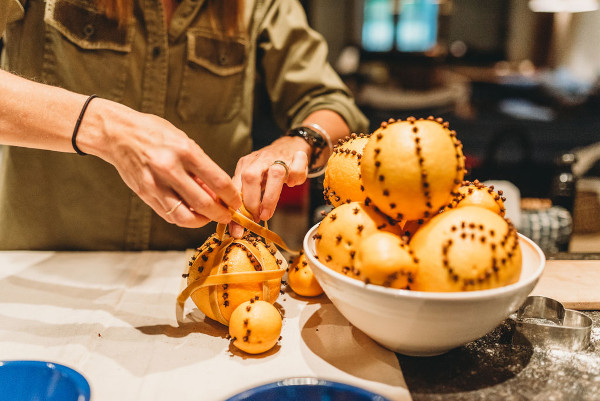
To prepare the toy:
- The orange (lemon or apple) should be wrapped in a circle with a satin ribbon so that 4 turns are obtained. In the central part of the pomander they should be tied into a bow. The remains of the material should be cut off.
- Using an awl, make many small holes on the fruit between the pieces of tape, and insert a clove into each of them.
- A ribbon loop needs to be tied to the pomander bow. The finished decoration can be hung on the Christmas tree and used to decorate the apartment.
Pomander-cone
Pomanted cone - a variant of New Year's decor, made in the form of a fir cone, can be made from tangerines and cloves. For a more persistent aroma, you can also use a mixture of various spices (coriander, cinnamon, nutmeg).
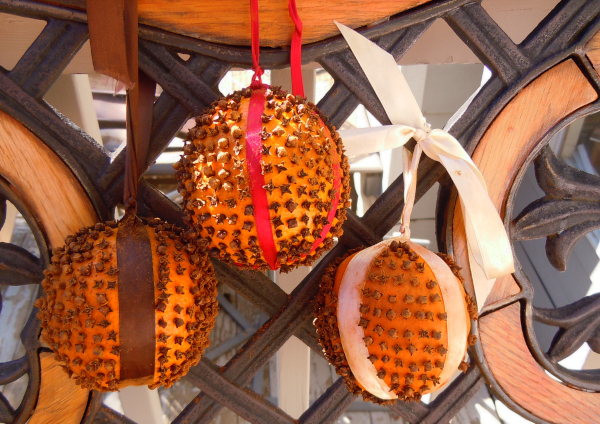
How to make:
- The tangerine needs to be wrapped crosswise with an elastic band (or thick thread) so that it divides the fruit into 2 parts.
- Using an awl, make small indentations to cover the fruit with cloves so that they cover the entire free surface of the tangerine.
- The prepared pomander should be placed in a paper bag. A mixture of spices should be poured on top of it: cinnamon, nutmeg, coriander, taken in any proportions. The paper bag should be tightly closed and put away to dry in a warm dry place for 2-4 weeks.
- After the specified period of time, the pomander should be taken out of the paper bag, tied with ribbon and hung on the Christmas tree.
Christmas tree made of pomanders
Pomanders made from tangerines or limes can be used to create an original New Year's composition, shaped like a small Christmas tree.
Materials required:
- small citrus fruits (30-40 pieces);
- carnation;
- cone-shaped base made of foam plastic;
- wooden skewers or shashlik skewers;
- pine branches.
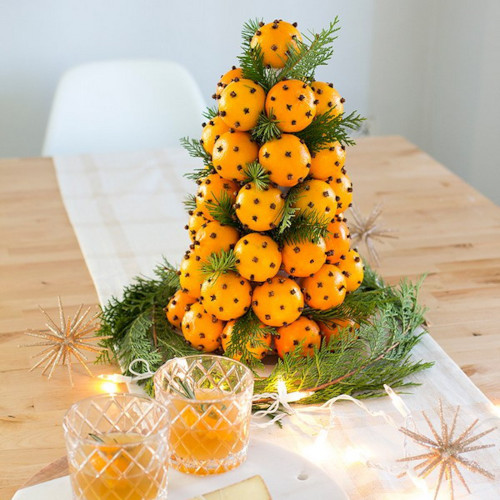
Manufacturing process:
- Small pomanders should be made from tangerines or limes. To do this, each fruit should be wrapped with a rubber band (paper strips, tape) so as to carefully divide the fruit into 4 equal parts. With an awl or toothpicks, many small holes should be made in the citrus peel in random order, into each of which a carnation inflorescence should be inserted.
- Wooden skewers (or sticks) should be cut into 10-12 cm sections.
- The resulting sticks should be inserted into the base of each of the tangerine pomanders. The opposite end of the stick should be attached to the bottom of the cone-shaped base so that the citrus fruits are located below the base of the base. To make the bottom of the pyramid, you will need 6-8 pomanders.
- In a similar manner, you need to attach pomanders to the 2nd and 3rd tiers of the pyramid, placing each subsequent one above the previous level.
- The empty space between the pomanders should be decorated with spruce branches. The resulting composition should be placed on a dish decorated with a coniferous base.
- You can put a miniature star on the top of the “tree” or decorate it with a small bow, and wrap the “trunk” with a mini battery-powered garland.
What can be added to the composition?
When making New Year's pomanders from citrus fruits or apples, you can use a variety of decor:
- decorate the product with shiny braid and a symmetrically placed pattern of carnations;
- place the pattern of carnations lengthwise or crosswise;
- place the spice decor parallel to the braid branch;
- lay out various figures from carnations (stars, hearts, diamonds);
- place spices on fruits in artistic disorder.
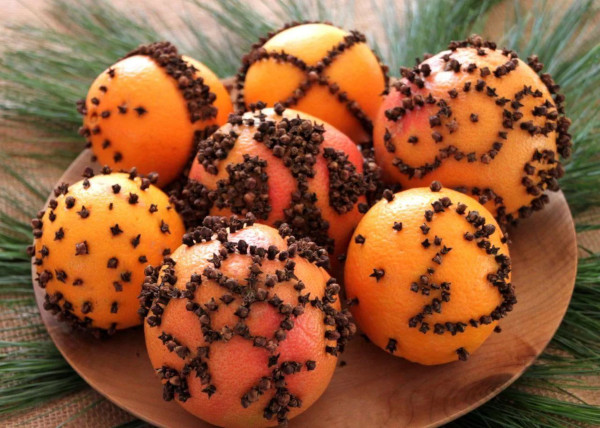
In addition to cloves, you can decorate the pomander with cinnamon sticks, vanilla or cardamom flowers.
The aromatic decoration is combined with:
- with coniferous branches;
- with spruce and pine cones;
- with fallen leaves from trees;
- with walnuts;
- with acorns and chestnuts.

Prepared and garnished with spices, the citrus pomander can be:
- place in a container with a recess, decorating with nuts, pine needles or “autumn” natural materials;
- hang around the house like a garland with pendants;
- use as a stand for an aromatic candle.
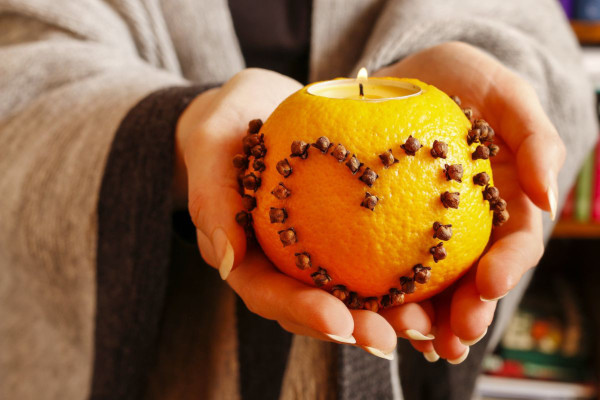
In the latter case, you need to make a hole in the middle of the orange, lemon or apple for the scented candle. In addition to the original decoration, this form of presentation will enhance the aromatic properties of the pomander.
Flower Pomander
A flower pomander is an exquisite decoration made of flower buds, traditionally used in Europe to decorate a bride's dress. You can make such a decoration not only in a salon, but also at home, and then use it as an original decoration for any festive event.

To make it you will need:
- small foam balls;
- thick, stiff colored paper (not cardboard);
- sharp scissors;
- long stationery pins with balls on the ends in a tone that matches the colored paper, a matching color, or a universal neutral shade;
- ribbons or twine (for hanging pomanders);
- vases, candlesticks, stands (optional);
- stencil of a flower with 4 petals or a figured hole punch.
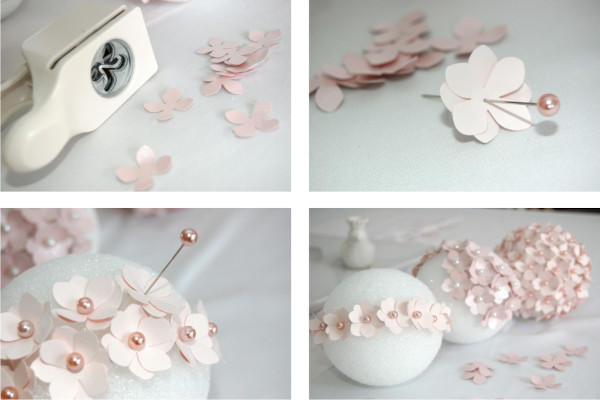
Manufacturing process:
- Before you start making the pomander, the foam ball should be evenly soaked in aromatic water. To do this, mix 4-5 drops of any essential oil (rose, ylang-ylang, sandalwood) in 250 ml of water. Place the foam ball in the resulting solution for 2-3 hours. After the specified time, the pomander base should be removed from the water and dried well. Preparations should be made 1-3 days before you start making the pomander.
- Using a flower stencil or a figured hole punch from thick colored paper, you need to make petals for the flowers. For each flower, you will need at least 5 petals. In total, for one pomander, you need to make at least 60 flowers.
- Flowers should be collected only on a completely dry pomander. To do this, 2 samples cut out of paper should be placed evenly one on top of the other so that the petals of the second are between the petals of the first. The resulting blank should be pierced in the center with a pin (its ball becomes the core of the flower), and the sharp end (together with the flower) should be put on the foam rubber. Flowers should be glued in even rows, starting from the middle of each ball. The ball should be completely covered with flowers.
- To hang a flower pomander, you need to glue a loop of ribbon or twine in its center. Its ends can be hidden under the flowers, additionally attached to the foam base with pins. The aromatic ball can also be placed in a vase, candlestick or any stand with a recess.
Recommendations for use
When using a pomander, remember that:
- The pomander retains its properties for 3-5 weeks. In order to restore its aromatic properties, decor experts advise sprinkling the ball with cinnamon or cardamom essential oils and placing it in a closed container for 4-6 days, having previously added spices to it. A flower pomander made of foam rubber should also be checked regularly, and if necessary, take out several flowers, spray the foam base with essential oils or replace it completely.
- The pomander should be kept out of reach of children and pets. This rule is especially relevant if sharp pins and a large number of spices were used to make the aromatic ball.
- Decor experts recommend using oranges or tangerines to make New Year's pomanders. Citrus fruits have thin skin, and when dried with spices, they can retain their aromatic properties for six months.
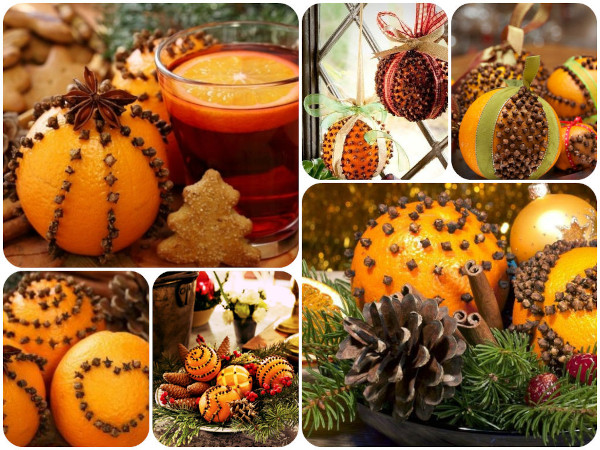
A pomander is a decorative aromatic decoration made from citrus fruits, spices and aromatic oils. Used to decorate a Christmas tree or decorate a room, the aromatic ball has been known since the Middle Ages, gradually turning from a luxury item into an original holiday decoration.
You can make a citrus or floral pomander with your own hands, using popular master classes that teach how to create original decorations that not only serve a decorative function, but also fill the room with a pleasant citrus or floral aroma.
Video about pomanders
How to make a New Year's pomander with your own hands:
